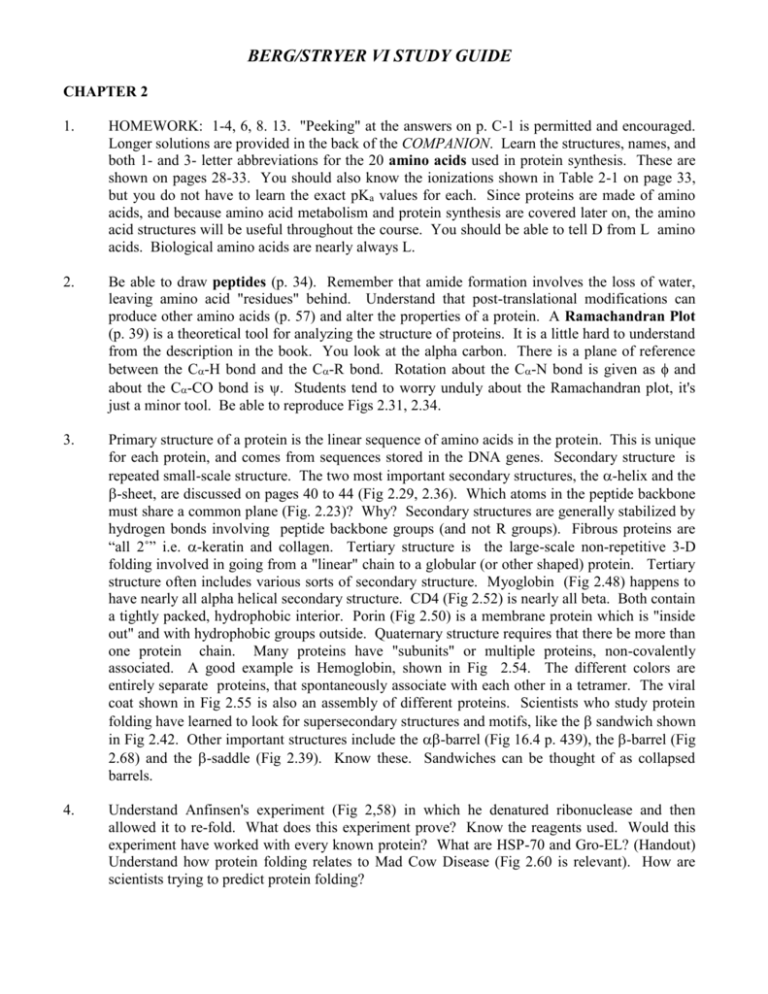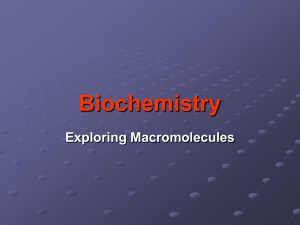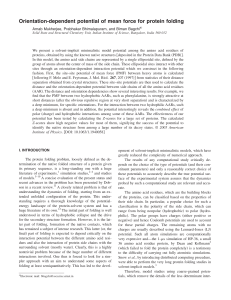CHAPTER 3
advertisement

BERG/STRYER VI STUDY GUIDE CHAPTER 2 1. HOMEWORK: 1-4, 6, 8. 13. "Peeking" at the answers on p. C-1 is permitted and encouraged. Longer solutions are provided in the back of the COMPANION. Learn the structures, names, and both 1- and 3- letter abbreviations for the 20 amino acids used in protein synthesis. These are shown on pages 28-33. You should also know the ionizations shown in Table 2-1 on page 33, but you do not have to learn the exact pKa values for each. Since proteins are made of amino acids, and because amino acid metabolism and protein synthesis are covered later on, the amino acid structures will be useful throughout the course. You should be able to tell D from L amino acids. Biological amino acids are nearly always L. 2. Be able to draw peptides (p. 34). Remember that amide formation involves the loss of water, leaving amino acid "residues" behind. Understand that post-translational modifications can produce other amino acids (p. 57) and alter the properties of a protein. A Ramachandran Plot (p. 39) is a theoretical tool for analyzing the structure of proteins. It is a little hard to understand from the description in the book. You look at the alpha carbon. There is a plane of reference between the C-H bond and the C-R bond. Rotation about the C-N bond is given as and about the C-CO bond is . Students tend to worry unduly about the Ramachandran plot, it's just a minor tool. Be able to reproduce Figs 2.31, 2.34. 3. Primary structure of a protein is the linear sequence of amino acids in the protein. This is unique for each protein, and comes from sequences stored in the DNA genes. Secondary structure is repeated small-scale structure. The two most important secondary structures, the -helix and the -sheet, are discussed on pages 40 to 44 (Fig 2.29, 2.36). Which atoms in the peptide backbone must share a common plane (Fig. 2.23)? Why? Secondary structures are generally stabilized by hydrogen bonds involving peptide backbone groups (and not R groups). Fibrous proteins are “all 2˚” i.e. -keratin and collagen. Tertiary structure is the large-scale non-repetitive 3-D folding involved in going from a "linear" chain to a globular (or other shaped) protein. Tertiary structure often includes various sorts of secondary structure. Myoglobin (Fig 2.48) happens to have nearly all alpha helical secondary structure. CD4 (Fig 2.52) is nearly all beta. Both contain a tightly packed, hydrophobic interior. Porin (Fig 2.50) is a membrane protein which is "inside out" and with hydrophobic groups outside. Quaternary structure requires that there be more than one protein chain. Many proteins have "subunits" or multiple proteins, non-covalently associated. A good example is Hemoglobin, shown in Fig 2.54. The different colors are entirely separate proteins, that spontaneously associate with each other in a tetramer. The viral coat shown in Fig 2.55 is also an assembly of different proteins. Scientists who study protein folding have learned to look for supersecondary structures and motifs, like the sandwich shown in Fig 2.42. Other important structures include the -barrel (Fig 16.4 p. 439), the-barrel (Fig 2.68) and the -saddle (Fig 2.39). Know these. Sandwiches can be thought of as collapsed barrels. 4. Understand Anfinsen's experiment (Fig 2,58) in which he denatured ribonuclease and then allowed it to re-fold. What does this experiment prove? Know the reagents used. Would this experiment have worked with every known protein? What are HSP-70 and Gro-EL? (Handout) Understand how protein folding relates to Mad Cow Disease (Fig 2.60 is relevant). How are scientists trying to predict protein folding?








